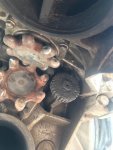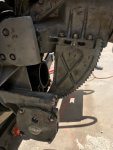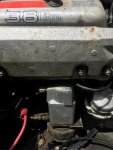Hold off on replacing the motor for your tilt. I have an OMC sterndrive (mine is a stringer 400. The 800, which you probably have, just uses different lower gears, but same tilt). I literally just finished repairing mine from the ground up. You hear a click, but the outdrive won’t raise. There are two separate problems. I had both.
- First, the simpler of the two. Once I repaired my other problem causing the tilt gear to jam, I had it all back together and the motor still clicked in both directions with no tilt movement. I had tested the motor and knew it worked. I have the OMC official 1985 service manual. There is a worm gear that engages the big brass gear. That worm gear is on a shaft that rides on two bronze bearings. One end connects to the motor. The site I buy parts from has an exploded view of the shaft for my exact stringer year and model. It shows a nylon washer between the rear brass bearing and back edge of the worm gear. I had replaced the old one. The old one was flat and thinner than tissue paper. It looked like snake skin at first. So, I put the washer on the shaft, then the worm drive. I put the end cap on that has the other brass bearing and O-ring to seal out water. I put the little triangle cover over it, and tighten the three nuts. Motor stuck. I loosen the 3 nuts. Tilt drive swings like dances doing a high kick. I experimentally tighten the cover a bit, test tilt, tighten again, test tilt. Once the cover was about, oh, as thick as a nylon washer away from being tight, the motor slowed. Nice the cover was tightened a bit more, the motor froze. I realized, despite that parts diagram, and consistent with the snakeskin like crushed one, that nylon washer didn’t belong. I removed it. Tightened cover. It worked. I think they made a modification, but the diagram is wrong. I think someone before me put a washer on too. I think the tilt worm gear is a bit longer now, or that washer never was supposed to be there and the parts diagram is completely wrong. The OMC 1985 sterndrive repair manual mentions a nylon washer in another location which simply doesn’t exist and they do not show a picture of it in the parts diagram in the manual or on online diagrams. They made either mistakes, or late changes. Loosen the bolts on the triangle cover above the trim gearbox. Back them out about 1/8 of an inch togive the wormgear shaft a little play. Lift your sterndrive by hand a bit. This will pull at the worm gear and loosen the shaft a bit. See if you can tilt up now. If you can, then try removing the nylon washer as follows. Take the the bolts off of the triangle cover just above the trim gearbox. You will see a solid round metal object. Manually lift your sterndrive a bit, and the brass gear engaged with the worm gear behind the cover will pop that metal piece out. You will see the worm drive. Lifetime high enough on the sterndrive to pull the worm gear out. See if there’s a nylon washer on the shaft. Might be crushed or unrecognizable. Remove it, reassemble. Test.
- My original real issue with the tilt. This is a “$500” boat my son found. It was someone else’s project boat. One of the plethora of things Wong is that the tilt motor just clicked. I removed the tilt motor to test it. It had enough torque to throw itself down into my bilge, so it was ok. It spun both directions. The tilt motor, btw is down on the lower right if you are facing the front of your engine. The worm gear shaft I describe above goes right into the motor, so just trace that shaft through the boat transom, and you will see the motor. Since the motor worked when not loaded by the shaft, I figured gears were jammed. I pulled the tilt cover off and saw brass shavings. The short version is that there is a hardened steel thrust washer on the other side of the clutch mechanism inside the tilt casing. It had shattered. The 10 or so pieces of this high carbon steel washer had been chewed by all the moving parts. The worm gear and brass gear ate some together. It tore up the cover where the big O-ring is. The brass gear rides in the cover, and in a big circle of metal in the t back channel was torn up too. Metal had begun to deposit in the channel, warping it. Eventually, the brass gear froze in that channel when a pice of the thrust washer was forced between it and the sterndrive case. I pryed the brass gear out. It was chewed up on the back. I bought a used replacement gear, used cover so the O-ring would seal. Used a dremel with a drum sander to remove metal deposits to make the gear race round and smooth. Brake cleaner to spray out all the metal. Cleaned the clutch components. New snap ring at one end. Had to use file to remove some burrs. Bought a new thrust washer (bevel toward the clutch for that thrust washer btw). Then I wandered what makes a thrust washer shatter in the first place. One face of the washer goes against the clutch shaft. The other goes against the sterndrive housing. I noticed a significant high spot. Don’t know why it was there, but looked like maybe it was deposited there from spinning metal that damaged it. I wanted the washer to lay flat so there was no repeat. Dremel with a flat grinding wheel to the rescue. I noticed that the broken thrust washer parts had embedded into the brass gear teeth. If metal is suck a tooth of a worm gear or the brass gear, it should be removed or the motor can’t turn the gear past that metal. The thrust washer could have shattered from someone over tightening the clutch tension bolt too (hex head bolt under the nylon nut).
So
- Excessive pressure on worm gear from nylon bushing that doesn’t belong.
- Broken metal (maybe the thrust washer)
- you can pop the worm gear out, then run the motor. You can put the shaft back in without the worm drive (and no cover for testing) and see if the motor turns both ways freely.
- Motor is directly behind worm drive shaft in boat.
- If you remove he motor, there’s a brass piece on he end of it. Be sure to retrieve it and make sure it isn’t broken in some way.























